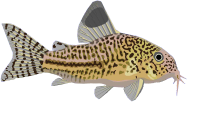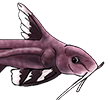I'm trying to get information to start my first real study in nearly thirteen years. Some people on here already know that I've been gearing up my fish room for larger production this year. In the process, I've started adding plants to my systems. This has been more for the sake of having the plants than for the fish. I've always kept mosses around for breeding purposes with no notable effect on the systems. However, I've found a trend that is starting to puzzle me with regards to my plecos and am curious if anyone else has seen the same.
I bought a group of ten earlier this year. When they arrived, it was an even mix of 5 male and 5 female that were separated by pairs in a central system. I've also added a trio of , three pair of , and seven semi-adult to adult . There are also four F-1 fry in the system that were originally placed there to control algae. The system receives six hours of direct sunlight every morning after I open the fish room and there was a massive algae/diatom bloom shortly after setting the system up.
As a result of the algae bloom, I added a couple hand fulls of Najas to one of the L262 tanks to act as a nutrient sponge and hopefully limit any new tank syndrome even though the system was seeded with water from another rack and mature sponge filters. This took place about a month after the system went online.
During the first month, I lost one of the female P. compta to injuries sustained while caved with her mate. The injuries appeared mild initially, but developed a bacterial infection within a few hours and she was dead the following morning.
I've since seen similar fighting amongst all the Peckoltia pairs. The most recent literally shed her skin and plates from the anterior dorsal fin all the way back past the adipose fin and nearly around the entire circumference of her body. I've seen quite a few "miracle recoveries" after 20+ years of breeding plecos, but this one would've normally been considered dead. For that reason, I didn't even bother trying to dose any medication to save her. My understanding has been this is a normal part of their life cycle and too much interference will only stress her worse and limit any chance at recovery. Surprisingly, she has nearly completely recovered in less than three weeks, but is only slowly starting to develop pigment in the outer edges of the damaged area.
Normally I wouldn't think anything of this, and would just call it a miracle. However, I've seen a few recoveries in this system in the past couple months that I would not have expected to survive. The system itself is maintained no differently than my others. The temperature ranged from 83 to 86 degrees with the higher temperature in the hottest part of the day. It receives a daily 4 percent water change via a drip emitter/overflow system on the sump. Feeding varies from two to five times a day depending on my availability. The only change I can find is the presence of the Najas.
I know this may be a bit far-fetched, but I'm starting to become curious whether this fast growing stem plant may be having a larger effect on the overall system than just acting as a nutrient sponge. My initial thought is the possibility it is limiting nutrients to bacterial growth in the system. Therefore, the lower bacterial count in the water isn't present in the quantities necessary to become disease causing. This would be the simplest conclusion.
However, there are others which would be nearly as simple. All of this is assuming the plant is having an ecological effect on the system beyond the obvious nutrient use.
I have noticed for a couple months that tanks containing this plant tend to develop a thick layer of mulm on the bottom between monthly bottom siphoning for rainy season simulations regardless of the number of fish in the tank. Initially I assumed this was excess food even though the tanks weren't fed any more than other tanks with fewer fish. I've since started wondering if this may be bacterial bio-film being shed by the plants as it develops on the leaves. It only develops in tanks containing the plant and the system sump and is visually different than the normal waste build-up.
From an evolutionary standpoint, the ability to prevent bacterial growth on the leaves would be a definite advantage.
At the same time, it could be something in the bio-film changing the system.
Or, it could be nothing more than healthy fish recovering from what they may consider a minor flesh wound.
My experience has taught me that plecos with exposed flesh/significant visible blood are dead fish. The results in this system are enough that I'm curious enough to look for an answer.
I know this probably goes outside the range of this site, but am looking for information from other pleco keepers/breeders that may be keeping plants in their tanks. I'm hoping to find a correlation that would possibly limit, or even end, the fighting deaths that occur in young adults. A list of the plant species being kept in the same system, the fish species, and observational info regarding fighting damage/deaths could all be beneficial. Given that I'm comparing against a single plant species, it may or may not be useful. However, it will be appreciated.
Larry
Looking for input on fighting injuries
- pleco_breeder
- Posts: 892
- Joined: 09 Dec 2003, 16:51
- My articles: 2
- My cats species list: 17 (i:0, k:0)
- Location 1: Arizona
- Interests: breeding plecos and corys
- Contact:
Looking for input on fighting injuries
Impossible only means that somebody hasn't done it correctly yet.
-
davej
- Posts: 39
- Joined: 28 Feb 2011, 00:09
- My cats species list: 3 (i:0, k:0)
- Location 2: Vancouver Canada
Re: Looking for input on fighting injuries
I don't keep plants in my pleco tank but experienced a similar outbreak.
I purchased 12 wild L134's. Within a few weeks of receiving them I experienced a similar outbreak.
With one fish loosing his pectoral fin in a very short time. The fish suffered from whitish patches on their backs with the skin appearing to melt away in a very short time. I figured that it was a columnaris outbreak and quickly dropped the temp down to 75f as higher temps cause columnaris to grow faster and do more damage at a quickend pace. I then treated the whole tank with Furan 2, it quickly got things under control. The one fish that was the worst was treated with a second course in a separate tank. All recovered fairly quickly and have been fine for over a year now. Hope this helps.
Dave
I purchased 12 wild L134's. Within a few weeks of receiving them I experienced a similar outbreak.
With one fish loosing his pectoral fin in a very short time. The fish suffered from whitish patches on their backs with the skin appearing to melt away in a very short time. I figured that it was a columnaris outbreak and quickly dropped the temp down to 75f as higher temps cause columnaris to grow faster and do more damage at a quickend pace. I then treated the whole tank with Furan 2, it quickly got things under control. The one fish that was the worst was treated with a second course in a separate tank. All recovered fairly quickly and have been fine for over a year now. Hope this helps.
Dave









